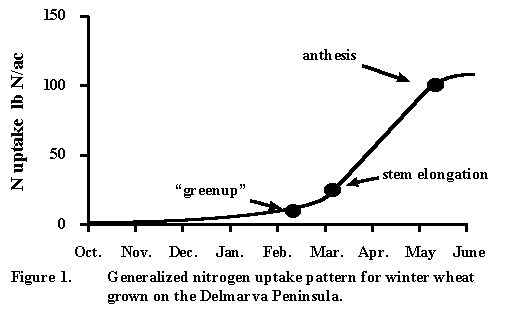
Current Status of Soil and Plant Nitrogen Testing for Winter Wheat
 |
Current Status of Soil and Plant Nitrogen Testing for Winter Wheat |
Introduction
Nitrogen (N) management for winter wheat is crucial to maximize crop recovery of fertilizer and manure N, attain optimum economic yields, and protect ground and surface waters from nitrate contamination. Seasonal application rates of N for wheat recommended by the University of Delaware (80-120 lb N/ac) are based on the amount of N needed to attain realistic yields. Insufficient N reduces yields and profits, but excessive N can produce wheat plants susceptible to lodging and disease, also reducing yields. The potential for contaminating ground and surface waters with N also increases with over-application of N in fertilizer or animal manures. Efficient management of N fertilizer rate and timing of application helps control N availability to wheat, produce high yields, and avoid nitrate contamination of ground and surface waters. Soil and plant testing for N can play an integral role in achieving this efficient management of N fertility.
Autumn and Winter Plant Growth and N Uptake

A timely planted wheat crop germinates, emerges, and tillers before winter
dormancy begins in December. Autumn dry matter production and N requirements are low
(Figure 1), but 20-30 lb N/ac is needed to establish the crop and promote root growth and
tiller production. This reduces winter-kill and enhances nutrient and moisture use during
spring growth. Excessive fall growth from over-fertilization with N can produce wheat
susceptible to disease and winterkill. Over-fertilization with N also increases the
potential for leaching losses during dormancy. Wheat uses little N during winter dormancy.
Applying N as fertilizers or manures during dormancy and expecting the N to be available
for spring growth and grain production is unreasonable.
Spring Plant Growth and N Uptake
Wheat breaks dormancy and resumes growth ("greenup") in late February or early March, but N uptake from mid February to mid March is only 10-20 lb N/ac (Figure 1). Although excessive N applications during this time can result in spindly plants more susceptible to lodging and disease, most N is typically applied now. In late March to early April, leaf sheath growth forces leaves to grow upright and signals the beginning of stem elongation, the most rapid phase of wheat growth and N uptake. Figure 1 shows the large N uptake from the onset of stem elongation to mid May. Sufficient N availability is critical at this growth stage to produce high yields. Insufficient N can cause tiller abortion, resulting in fewer heads and lower yields. Because recovery of N applied during this period is high due to the extensive wheat root system, large plant N uptake, and high evapotranspiration, N leaching losses are unlikely. Plant N uptake during grain fill (mid May to early June), is minimal compared to during stem elongation.
Prepared by Peter A. Vadas and Dr. Tom Sims, Department of Plant and
Soil Sciences, University of Delaware. Based on Nitrogen Management for Winter Wheat:
Principles and Recommendations, by M.M. Alley et al., Virginia Tech, Blacksburg Va,
and Using a Chlorophyll Meter to Predict Nitrogen Fertilizer Needs of Winter Wheat, by
R.H. Fox et al., Pennsylvania State University, University Park, PA.